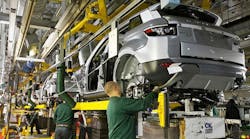Newark element14’s Richard Halliday says he expects the distributor’s industrial automation business to outpace its core business growth this year, as design engineers and production customers keep busy in North America. Halliday is director of product marketing for Newark element14, and he credits much of the opportunity to the company’s focus on both the design and production sides of the manufacturing economy.
“We have the board-level components and then we have the products used at the other end of the design lifecycle,” explains Halliday. “So that’s what encourages me a lot about the coming year… We would expect some solid, high single-digit growth.”
“One of the things I’m finding very compelling in the industrial automation space is that folks are reaching out online to get answers,” says Richard Halliday, director of product marketing for Newark element14. “It’s one of the reasons we made an effort to create our industrial automation microsite.”
Halliday isn’t alone in his outlook. Other large distributors specializing in industrial automation reported optimism as 2013 began, pointing to growth in energy and automotive markets in particular. Allied Electronics’ Mark Simon says he’s hopeful the growth Allied saw early in the year is a harbinger of more to come in 2013. He says Allied saw some growth in January and that early indicators pointed to growth in February, the final month of the distributor’s fiscal year. The good start came as welcome news amidst continuing concerns about the so-called “fiscal cliff” here at home.
“There have been a number of companies that have lost government incentives going into this year, so there’s that caution,” says Simon, Allied’s vice president of sales. “But looking at the year 2013 as a whole, we’re hoping we can produce 3% to 4% growth as a business.”
Indeed, supply chain companies are betting on facility upgrades, new projects, and customers’ thirst for product and process innovation to drive that growth this year.
Auto, Energy Markets Bode Well
Halliday points to aerospace and automotive markets as good opportunities for factory automation projects this year, especially as original equipment manufacturers (OEMs) and contract manufacturers (CMs) look to upgrade and enhance existing production lines.
“One of the things we are seeing is there is a bit of a move to get a little bit more manufacturing occurring in the United Sates, so that presents certain opportunities,” Halliday explains, pointing to CMs, in particular, which are building new facilities or moving some back to the United States. Both situations create opportunities for supplying the newest technologies to streamline the production process.
“Those are a couple of pieces that, for us, look pretty positive,” he adds.
On the process side of the business, Halliday points to the oil and gas markets. Those customers are increasingly looking for new technologies such as high-performance sensors, creating an opportunity he says he expects will continue throughout the year. Simon concurs about the energy market, pointing to recently released projects in certain regions that spell opportunity for Allied in 2013.
“Energy is very good,” Simon says. “It did start to flatten at the end of July, when we started to see some big customers [have] cancellations, but it didn’t last long. I’ve had some reports from Houston and Oklahoma that there are some projects that are starting to release again, so that’s a positive.”
Simon says the biggest slowdown is among military and defense customers as they struggle to deal with federal budget reductions. Although some projects are going forward, he says the uncertainty surrounding which ones will be funded is a key concern.
On the positive side, product advances are helping drive business as customers look for new technologies to streamline processes and save costs. For example, Simon says demand for wireless products continues to grow, particularly because of their ability to reduce installation and maintenance costs in production environments. Wireless solutions are easier to deploy and to repurpose if the customer needs to make a change, he says.
“If you’ve got a production line and you’ve got to reconfigure it, wireless makes it so much easier to do that,” notes Simon. “There are still a lot of upgrades going through that are still wired, but there’s a lot of development by the manufacturers and a big appetite for wireless [solutions].”
More Information, Education
Halliday agrees customers are looking for solutions that simplify their processes, but he says he’s also seeing greater demand for information, which is driving online content development among distributors. In the last year, many large distributors have developed application-specific microsites—places within their Web sites that aggregate product information, news, technical assistance, and other information in specific markets such as industrial automation.
“One of the things I’m finding very compelling in the industrial automation space is that folks are reaching out online to get answers,” says Halliday. “It’s one of the reasons we made an effort to create our industrial automation microsite.”
The microsite is part of Newark’s element14 online community, which serves as an online resource and communication network for design engineers and procurement professionals. Newark added the microsite late last year, and it includes product information, training, technical resources, and discussion forums.
“There are a lot of questions out there. And there is that inherent knowledge in the industry, but it doesn’t always transition smoothly to the next generation of engineers,” says Halliday. “We’re seeing that pass along on the element14 community.”










